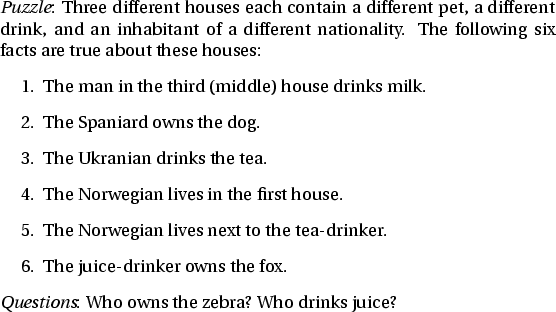 |
We now provide a simplified form of the Zebra Puzzle (Figure 4.2), a common puzzle for constraint resolution. This puzzle was solved by Aït-Kaci (1984) using roughly the same methods as we use here. The puzzle illustrates the expressive power of the combination of extensional types, inequations and type constraints. Such puzzles, sometimes known as logic puzles or constraint puzzles, require one to find a state of affairs within some situation that simultaneously satisfies a set of constraints. The situation itself very often implicitly levies certain constraints.
We can represent the simplified Zebra Puzzle in ALE as:
% Subsumption
%=======================
bot sub [house,descriptor,background].
descriptor sub [nat_type,ani_type,bev_type].
nat_type sub [norwegian,ukranian,spaniard].
norwegian sub [].
ukranian sub [].
spaniard sub [].
ani_type sub [fox,dog,zebra].
fox sub [].
dog sub [].
zebra sub [].
bev_type sub [juice,tea,milk].
juice sub [].
tea sub [].
milk sub [].
house sub []
intro [nationality:nat_type,animal:ani_type,beverage:bev_type].
background sub [clue]
intro [house1:house,house2:house,house3:house].
clue sub [maximality].
maximality sub [].
ext([norwegian,ukranian,spaniard,fox,dog,zebra,juice,tea,milk]).
% Constraints
%=============================
background cons
(house1:nationality:N1, % inequational constraints
house2:nationality:(N2,(=\= N1)),
house3:nationality:((=\= N1),(=\= N2)),
house1:animal:A1,
house2:animal:(A2,(=\= A1)),
house3:animal:((=\= A1),(=\= A2)),
house1:beverage:B1,
house2:beverage:(B2,(=\= B1)),
house3:beverage:((=\= B1),(=\= B2))).
clue cons
(house3:beverage:milk, % clue 1
(house1:nationality:spaniard,house1:animal:dog % clue 2
;house2:nationality:spaniard,house2:animal:dog
;house3:nationality:spaniard,house3:animal:dog),
(house1:nationality:ukranian,house1:beverage:tea % clue 3
;house2:nationality:ukranian,house2:beverage:tea
;house3:nationality:ukranian,house3:beverage:tea),
house1:nationality:norwegian, % clue 4
(house1:nationality:norwegian,house2:beverage:tea % clue 5
;house2:nationality:norwegian,house3:beverage:tea
;house2:nationality:norwegian,house1:beverage:tea
;house3:nationality:norwegian,house2:beverage:tea),
(house1:beverage:juice,house1:animal:fox % clue 6
;house2:beverage:juice,house2:animal:fox
;house3:beverage:juice,house3:animal:fox)).
maximality cons
(house1:nationality:(norwegian;ukranian;spaniard), % maximality constraints
house2:nationality:(norwegian;ukranian;spaniard),
house3:nationality:(norwegian;ukranian;spaniard),
house1:animal:(fox;dog;zebra),
house2:animal:(fox;dog;zebra),
house3:animal:(fox;dog;zebra),
house1:beverage:(juice;tea;milk),
house2:beverage:(juice;tea;milk),
house3:beverage:(juice;tea;milk)).
The subsumption hierarchy is shown pictorially in
Figure 4.3. The type, background, with the
assistance of the types subsumed by house and descriptor,
represents the situation of three houses (the features of background), each of which has three attributes (the features of
house). The implicit constraints levied by the situation appear
as constraints on the type, background, namely that no two
houses can have the same value for any attribute. These are
represented by inequations. But notice that, since we are interested
in treating the values of attributes as tokens, we must represent
those values by extensional types. If we had not done this, then we
could still, for example, have two different houses with the beverage,
juice, since there could be two different feature structures of
type juice that were not token-identical. Notice also that all
of these types are maximal, and hence satisfy the restriction that
ALE places on extensional types.
The explicit constraints provided by the clues to the puzzle are represented as constraints on the type clue, a subtype of background. We also need a subtype of clue, maximality, to enforce another constraint implicit to all constraint puzzles, namely the one which requires that we provide only maximally specific answers, rather than vague solutions which say, for example, that the beverage for the third house is a type of beverage (bev_type), which may actually still satisfy a puzzle's constraints.
To solve the puzzle, we simply type:
| ?- mgsat maximality.
MOST GENERAL SATISFIER OF: maximality
maximality
HOUSE1 house
ANIMAL fox
BEVERAGE juice
NATIONALITY norwegian
HOUSE2 house
ANIMAL zebra
BEVERAGE tea
NATIONALITY ukranian
HOUSE3 house
ANIMAL dog
BEVERAGE milk
NATIONALITY spaniard
ANOTHER? y.
no
| ?-
So the Ukranian owns the zebra, and the Norwegian drinks juice. A
most general satisfier of maximality will also satisfy the
constraints of its supertypes, background and clue.
Although ALE is capable of representing such puzzles and solving them, it is not actually very good at solving them efficiently. To solve such puzzles efficiently, a system must determine an optimal order in which to satisfy all of the various constraints. ALE does not do this since it can express definite clauses in its constraints, and the reordering would also be very difficult for the user to keep track of while designing a grammar. A system that does do this is the general constraint resolver proposed by Penn and Carpenter (1993)4.16.